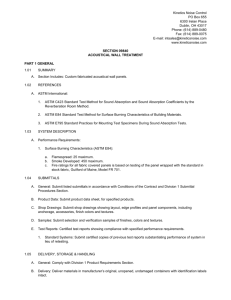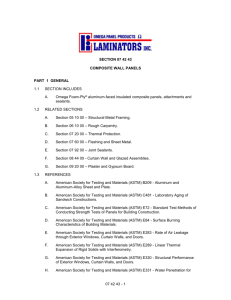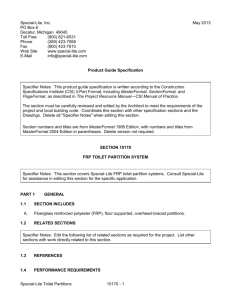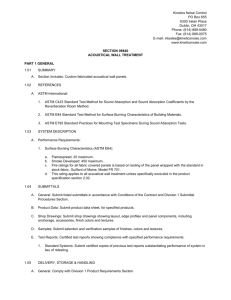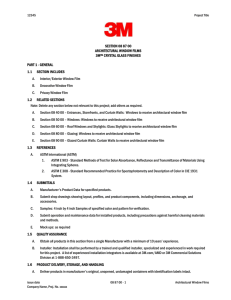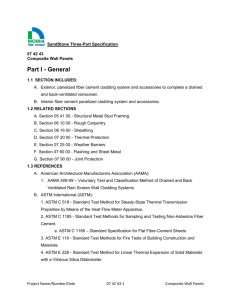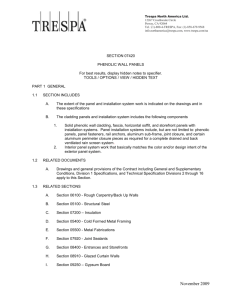Section 09800 - ACOUSTICAL TREATMENT
advertisement
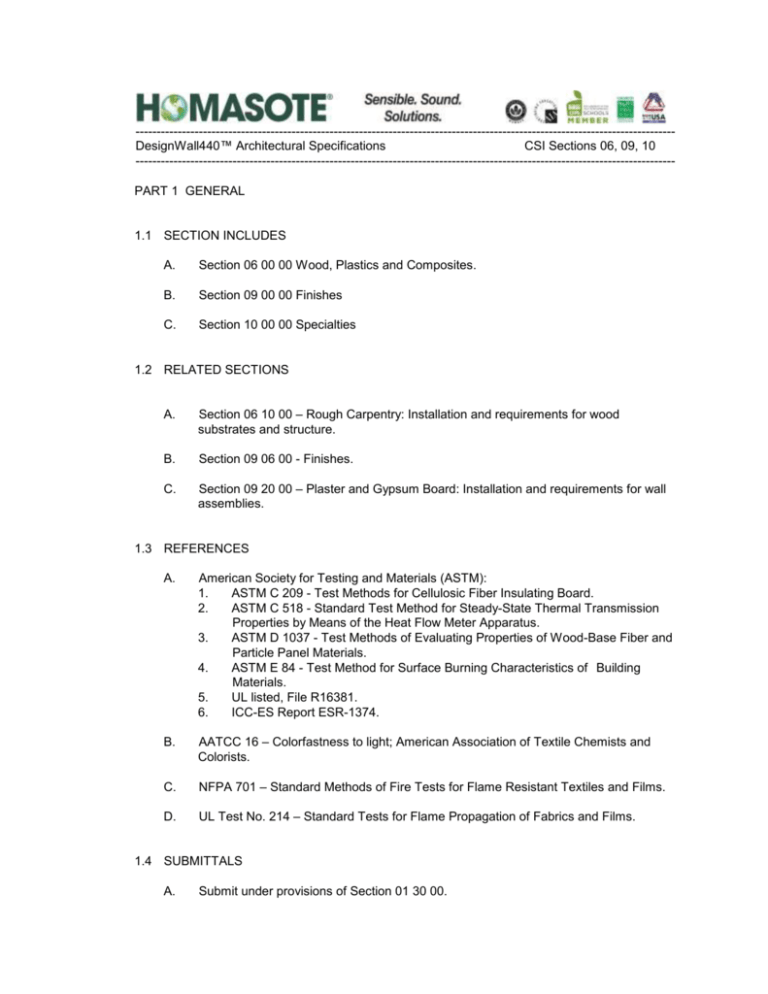
-------------------------------------------------------------------------------------------------------------------------------DesignWall440™ Architectural Specifications CSI Sections 06, 09, 10 -------------------------------------------------------------------------------------------------------------------------------PART 1 GENERAL 1.1 SECTION INCLUDES A. Section 06 00 00 Wood, Plastics and Composites. B. Section 09 00 00 Finishes C. Section 10 00 00 Specialties 1.2 RELATED SECTIONS A. Section 06 10 00 – Rough Carpentry: Installation and requirements for wood substrates and structure. B. Section 09 06 00 - Finishes. C. Section 09 20 00 – Plaster and Gypsum Board: Installation and requirements for wall assemblies. 1.3 REFERENCES A. American Society for Testing and Materials (ASTM): 1. ASTM C 209 - Test Methods for Cellulosic Fiber Insulating Board. 2. ASTM C 518 - Standard Test Method for Steady-State Thermal Transmission Properties by Means of the Heat Flow Meter Apparatus. 3. ASTM D 1037 - Test Methods of Evaluating Properties of Wood-Base Fiber and Particle Panel Materials. 4. ASTM E 84 - Test Method for Surface Burning Characteristics of Building Materials. 5. UL listed, File R16381. 6. ICC-ES Report ESR-1374. B. AATCC 16 – Colorfastness to light; American Association of Textile Chemists and Colorists. C. NFPA 701 – Standard Methods of Fire Tests for Flame Resistant Textiles and Films. D. UL Test No. 214 – Standard Tests for Flame Propagation of Fabrics and Films. 1.4 SUBMITTALS A. Submit under provisions of Section 01 30 00. B. Product Data: Manufacturer's data sheets on each product to be used, including: 1. Preparation instructions and recommendations. 2. Storage and handling requirements and recommendations. 3. Installation methods. C. Samples: Two each of manufacturer’s full range of fabric colors applied to substrate material; 7 by 7 inches (180mm by 180mm). D. Closeout Submittals: Maintenance and Cleaning instructions. 1.5 QUALITY ASSURANCE A. Manufacturer Qualifications: Minimum 10 years experience in producing sounddeadening boards. 1.6 DELIVERY, STORAGE, AND HANDLING A. Store products in manufacturer's unopened packaging with labels intact until ready for installation. B. Inspect the materials upon delivery to assure that specified products have been received. Report damaged material immediately to the delivering carrier and note such damage on the carrier's freight bill of lading. C. Store materials in a dry place, indoors, on raised platform protected from weather damage. 1.7 PROJECT CONDITIONS A. Maintain environmental conditions (temperature, humidity, and ventilation) within limits recommended by manufacturer for optimum results. Do not install products under environmental conditions outside manufacturer's absolute limits. B. Acclimatize panels to existing moisture conditions and for not less than 24 hours before installation. Comply with manufacturer’s recommendations for acclimatization. PART 2 PRODUCTS 2.1 MANUFACTURERS A. Acceptable Manufacturer: Homasote Company; 932 Lower Ferry Road, West Trenton, NJ 08628. Tel: (800) 257-9491. Tel: (609) 883-3300. Fax: (609) 883-3497. Email: sales@homasote.com. Website: www.homasote.com. B. Requests for substitutions will be considered in accordance with provisions of Section 01 60 00. C. Substitutions: Not permitted. D. Provide all fabric-covered acoustical wall panels from a single manufacturer. 2.2 MATERIALS A. Homasote DesignWall440 Panel: Class C fire-rated Homasote 440 substrate; a molded, recycled post-consumer paper, cellulose fiber structural panel. Physical properties of substrate are as follows: 1. Thickness: 1/2 inch (13 mm), 4’ x 8’, 4’ x 10’. 2. Density: 26-28 pcf (416-448 kg/cu. m) tested in accordance with ASTM C 209. 3. Tensile Strength: When tested in accordance with ASTM C 209: a. Parallel: 450-700 psi (3,100-4,830 kPa). b. Transverse: 750-1000 psi (5,1171-6,894 kPa). 4. Hardness (Janka Ball): 230 lbs (104 kg) tested in accordance with ASTM D 1037. 5. Water Absorption by Volume: When tested in accordance with ASTM C 209: a. 2 hour immersion: 7 percent maximum. 6. Expansion: 50 to 90 percent relative humidity, 0.25 percent in accordance with ASTM C 209. 7. Thermal Resistance: When tested in accordance with ASTM C 209 per ASTM C 518: a. R-value: 1.2 for 1/2 inch (13 mm) thick board. 8. Noise reduction coefficient (NRC): 0.20 9. Flame Spread: 76 to 200 tested in accordance with ASTM E 84, Class III or C. B. Fabric: FR701® as manufactured by Guilford of Maine. Physical properties as follows: 1. Content: 100% percent polyester. 2. Weight: 16.0 lbs. +/- 0.5 lbs. per linear yard (16 g/m). 3. Tensile strength: 150 lbs. min. 4. Tear strength: 30 lbs. min. 5. Colorfastness to light: No less than Grade 4 after 40 hours, per AATCC 16, Option A. 6. Colorfastness to Crocking: Class 4 min.-dry; Class 4 min.-wet. 7. Moisture regain - .5% max. 8. ASTM E84: Class A. 9. NFPA-701 Passes. 10. UL Test No. 214: Passes. 11. FAA (Para.25.853B): Passes. 12. NY/NJ Port Authority (FMTS 191-5903): Passes. 13. Boston Fire Code BFD IX-1: Passes. 14. State of Massachusetts 527 CMR 21.00: Passes. 15. State of California Tech Bulletin 117 Section E (CS-191-53): Passes. 16. GSA-PBS: Passes. 17. Color: 380 Quartz. 18. Color: 401 Blue Neutral 19. Color: 238 Grey Mix. 20. Color as selected by Architect from manufacturer’s standard range. C. Edge detail: Fabric wrapped along long edges only. 4’ edges are unwrapped. Fabric adhered to face of the substrate. 2.3 ACCESSORIES A. Metal Frame Clips: Manufacturer’s standard clip for securing panels to framing. B. Adhesive: APA approved panel adhesive. C. Adhesive: APA AFG-01 specification adhesive. D. Wall Panel Fasteners: 1. Nails: Color coordinated or decorative for paneling. Length required penetrating wood framing 3/4 inch (19 mm) minimum. 2. Screws: a. General: 20 gauge or heavier, self-tapping drywall type steel screw. b. Wood Framing: Coarse thread drywall type wood screw, length as required to penetrate framing 3/4 inch (19 mm) minimum. c. Metal Framing: 22-25 gauge, drywall type steel screw. d. Decorative exposed fasteners determined by architect/specifier. PART 3 EXECUTION 3.1 EXAMINATION A. Examine substrates upon which work will be installed. B. Verify framing member spacing complies with manufacturer’s requirements depending on substrates and installation methods. C. If substrate preparation is the responsibility of another installer, notify Architect of unsatisfactory preparation before proceeding. D. Verify what environmental conditions are, and will continue to be maintained in accordance with manufacturer’s recommendations. E. Starting work by installer is acceptance of substrate and environmental conditions. 3.2 PREPARATION A. Follow manufacturer’s instructions by separating and allowing panels to be exposed to environmental temperature and humidity conditions for not less than 24 hours before start of installation. B. Temporarily position DesignWall440 panels in place and request architects’ approval, to ensure that desired appearance is obtained. 3.3 INSTALLATION A. Install in accordance with manufacturer's instructions. B. Install only clean dry panels. Do not install wet panels. C. Refer to manufacturer’s installation instructions for proper procedures regarding the cutting and painting of the panel. D. Wall Panel Installation: Space panel joints 1/8 inch (3 mm) apart; 1/4 inch (6 mm) space at floors, ceilings, and window and door frames. Install gypsum wallboard or other wall finish panels first so that finish panel joints are staggered and do not coincide with DesignWall440 joints. Install in accordance with finish panel manufacturer’s installation recommendations. 3.4 PROTECTION A. Protect installed products until completion of project. B. Touch-up, repair, or replace damaged products before Substantial Completion. 3.5 CLEANING A. Comply with manufacturer's recommendations for panel cleaning procedures. B. Comply with manufacturer’s recommendations for repairing damaged panels. C. Replace panels that cannot be repaired.
